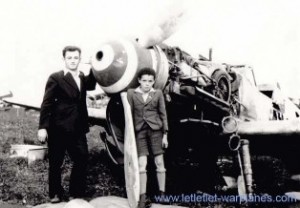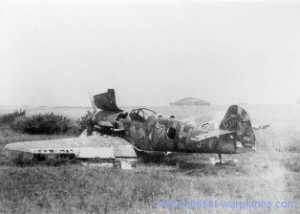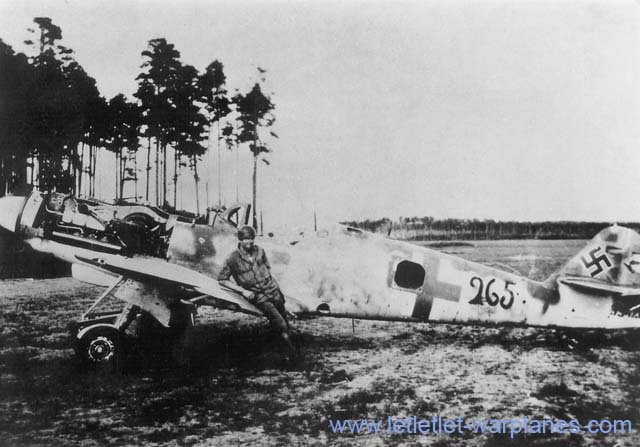Messerschmitt Bf 109 K
The Messerschmitt Bf 109 K (“Kurfürst”) was an enhanced version of the successful G (“Gustav”) type. Since the Gustav had so many subtypes, it was decided to create a new designation which should carry on the best attributes of the G-10 and G-14 types with some new improvements. The prototype Bf 109 K was converted from the cells of a G-10 model and given the designation Bf 109 K-0. It was equipped with the Daimler Benz DB 605 DM motor and arned with 2 × 13 mm MG 131, 1 × 30 mm MK 108-maschine-guns. It had no pressurized cabin. The next developement phase brought the Bf 109 K-2 which was basically the same as the K-0 but could be equipped with the DB 605 DM, DB oder DC with MW 50-injection motors. The K-2 never went into mass production. The studies of K-1 and K-3 remained drafts that were never realized into a prototype airplane.
 The only type that came into mass production in higher numbers was the K-4 type. The Kurfürst was first delivered in Autumn 1944 and was built as the last example of the Bf 109 that saw combat action.The 109-K4 was produced in the factory in Regensburg which produced 856 planes until end of 1944. When the war came to an end ca 1200 Bf 109 Ks were delivered to the German Staffeln. The “Kurfüst” K-4 was driven by the Daimler-Benz 12-cylinder-V-Motor DB 605 DC with 1010 kW (1370 hp) and with the big charger of the DB 603 . Starting power with methanol/water-injection (MW 50) for a short time up to 1470 kW (2000 hp). The K-4 had a range of approximately 570 km and if equipped with an additional 300 liters tank, up to 850 km.
The only type that came into mass production in higher numbers was the K-4 type. The Kurfürst was first delivered in Autumn 1944 and was built as the last example of the Bf 109 that saw combat action.The 109-K4 was produced in the factory in Regensburg which produced 856 planes until end of 1944. When the war came to an end ca 1200 Bf 109 Ks were delivered to the German Staffeln. The “Kurfüst” K-4 was driven by the Daimler-Benz 12-cylinder-V-Motor DB 605 DC with 1010 kW (1370 hp) and with the big charger of the DB 603 . Starting power with methanol/water-injection (MW 50) for a short time up to 1470 kW (2000 hp). The K-4 had a range of approximately 570 km and if equipped with an additional 300 liters tank, up to 850 km.
 Further improvements were new rest covering caps for the undercarriage and a fully divestible spur wheel (including the caps). Bigger tires were mounted which had a size of 660×190 on 13″ rims so that the K was able to carry the larger flying weight. The thickness of the wings was aerodynamically increased and the rest covering caps recveived small bulges. The aerial mast was not used any more to decrease the drag force and to enable the pilot to eject more safely. The loop aerial of the FuG 16ZY was mounted more at the fuselage’s back and shifted to fuselage part 3. Further development projects like the K-6 and K-8 which were equipped with the Motor DB 605 DC never were produced. The same can be said about the K-14 would have a DB 605 L motor.
Further improvements were new rest covering caps for the undercarriage and a fully divestible spur wheel (including the caps). Bigger tires were mounted which had a size of 660×190 on 13″ rims so that the K was able to carry the larger flying weight. The thickness of the wings was aerodynamically increased and the rest covering caps recveived small bulges. The aerial mast was not used any more to decrease the drag force and to enable the pilot to eject more safely. The loop aerial of the FuG 16ZY was mounted more at the fuselage’s back and shifted to fuselage part 3. Further development projects like the K-6 and K-8 which were equipped with the Motor DB 605 DC never were produced. The same can be said about the K-14 would have a DB 605 L motor.

Data for Bf 109 K-4 Model
base model: Bf 109 K-0
changes: GM-1-Anlage
purpose: fighter
wingspan: 9,92 m
length: 8,85 m
height : 2,59 m
aerodynamic surface : 16,4 m²
flying weight : 3374 kg
speeds:
maximum (on the ground): 728 km/h
maximum (in 7500 m): 645 km/h
travel speed (in 8400 m): 150 km/h
landing speed: 515 km/h
ceiling: 12.500 m
motor: Daimler-Benz 605 DC (1370 hp-(2000 hp with GM-1)
range : 570 km
equippment: VDM-three blade propeller
GM-1-Anlage
Erla cowling
armament: 2 x 13 mm MG 131 (over the motor)
1 x 30 mm MK 108 (through the propeller cylinder)
variants:
K-4/R1: fighter-bomber – ETC 500/IX for a 500 kg or a 250 kg bomb under the fuselage
K-4/R2: reconnaissance – equipped with MW 50 and cameras
K-4/R3: fighter with expanded range – 300-l-extra tank unter the fuselage
K-4/R4: heavy fighter – each a MG 151/20 unter each wing
K-4/R6: fighter – equipped with a ballistic gun kamera BSK 16
wireless equippment: FuG 16 ZY
Kilian Weimann
Color profiles- Srecko Bradic Images- B. Barbas, Z. Noevole
Sources:
http://www.eads.net/1024/de/eads/history/airhist/1930_1939/me109_1934.html
http://www.messerschmitt-bf109.de/
http://www.adlertag.de/flugzeuge/bf109k.htm
http://de.wikipedia.org/wiki/Messerschmitt_Bf_109









